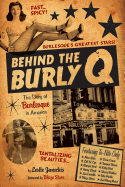
Despite the pornographic reputation attached to it, the original intent of burlesque served a much deeper purpose. Burlesque had its roots in European commedia dell'arte and vaudeville, but the Americans took the comedy and embellished it with the striptease in the 1920s. At its height, between the 1930s and 1950s, burlesque was a pre-feminist movement offering women economic empowerment and escape from poverty, as well as a "show that cost a few pennies and gave out-of-work men some semblence of hope." This era enthralled filmmaker Leslie Zemeckis, inspiring her to capture burlesque in all its naked glory. Behind the Burly Q is a companion volume to her 2011 documentary, which in turn arose from her own one-woman Mae West–style burlesque show.
Zemeckis introduces us to performers like Lili St. Cyr, Blaze Starr and Tempest Storm, as well as the comedians who opened for them, including Red Buttons, Phil Silvers and Abbott and Costello, and theater managers like Harold Minsky who promoted the tease to wider audiences. Alan Alda and Erik Lee Preminger, sons of straightman Robert Alda and Gypsy Rose Lee, respectively, provide intimate details of life in the shadow of parents always "on the wheel."
Zemeckis's easy rapport with the women who teased and seduced their way into the hearts of America gives voice to a generation of performers whose reputations have been maligned and largely forgotten--until now. --Nancy Powell, freelance writer and technical consultant

